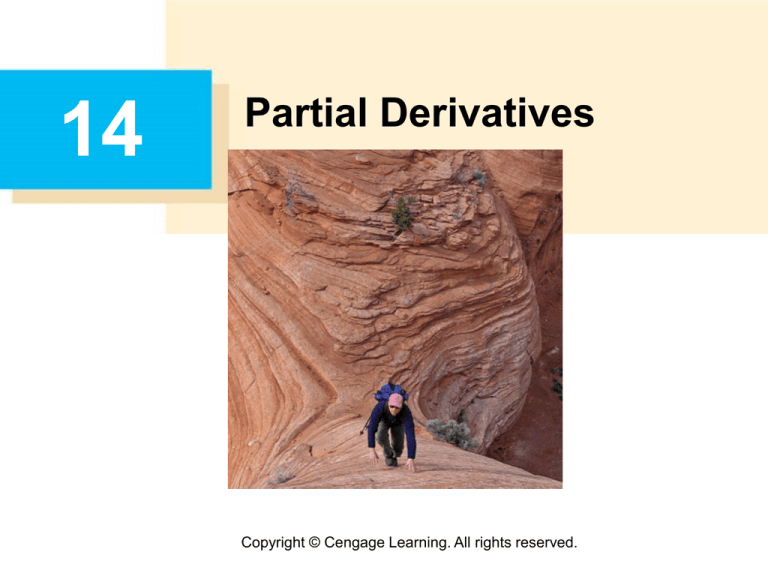
14
Partial Derivatives
Copyright © Cengage Learning. All rights reserved.
14.3
Partial Derivatives
Copyright © Cengage Learning. All rights reserved.
Partial Derivatives
On a hot day, extreme humidity makes us think the
temperature is higher than it really is, whereas in very dry
air we perceive the temperature to be lower than the
thermometer indicates.
The National Weather Service has devised the heat index
(also called the temperature-humidity index, or humidex, in
some countries) to describe the combined effects of
temperature and humidity.
The heat index I is the perceived air temperature when the
actual temperature is T and the relative humidity is H.
So I is a function of T and H and we can write I = f(T, H).
3
Partial Derivatives
The following table of values of I is an excerpt from a table
compiled by the National Weather Service.
Heat index I as a function of
temperature and humidity
Table 1
4
Partial Derivatives
If we concentrate on the highlighted column of the table,
which corresponds to a relative humidity of H = 70%, we
are considering the heat index as a function of the single
variable T for a fixed value of H. Let’s write g(T) = f(T, 70).
Then g(T) describes how the heat index I increases as the
actual temperature T increases when the relative humidity
is 70%.
The derivative of g when T = 96F is the rate of change of
I with respect to T when T = 96F:
5
Partial Derivatives
We can approximate g(96) using the values in Table 1 by
taking h = 2 and –2:
Averaging these values, we can say that the derivative
g(96) is approximately 3.75.
6
Partial Derivatives
This means that, when the actual temperature is 96F and
the relative humidity is 70%, the apparent temperature
(heat index) rises by about 3.75F for every degree that the
actual temperature rises!
7
Partial Derivatives
Now let’s look at the highlighted row in Table 1, which
corresponds to a fixed temperature of T = 96F.
Heat index I as a function of
temperature and humidity
Table 1
8
Partial Derivatives
The numbers in this row are values of the function
G(H) = f(96, H), which describes how the heat index
increases as the relative humidity H increases when the
actual temperature is T = 96F.
The derivative of this function when H = 70% is the rate of
change of I with respect to H when H = 70%:
9
Partial Derivatives
By taking h = 5 and –5, we approximate G(70) using the
tabular values:
By averaging these values we get the estimate
G(70) 0.9. This says that, when the temperature is 96F
and the relative humidity is 70%, the heat index rises about
0.9F for every percent that the relative humidity rises.
10
Partial Derivatives
In general, if f is a function of two variables x and y,
suppose we let only x vary while keeping y fixed, say y = b,
where b is a constant.
Then we are really considering a function of a single
variable x, namely, g(x) = f(x, b). If g has a derivative at a,
then we call it the partial derivative of f with respect to x
at (a, b) and denote it by fx(a, b). Thus
11
Partial Derivatives
By the definition of a derivative, we have
and so Equation 1 becomes
12
Partial Derivatives
Similarly, the partial derivative of f with respect to y at
(a, b), denoted by fy(a, b), is obtained by keeping x fixed
(x = a) and finding the ordinary derivative at b of the
function G(y) = f(a, y):
With this notation for partial derivatives, we can write the
rates of change of the heat index I with respect to the
actual temperature T and relative humidity H when
T = 96F and H = 70% as follows:
fT (96, 70) 3.75
fH(96, 70) 0.9
13
Partial Derivatives
If we now let the point (a, b) vary in Equations 2 and 3,
fx and fy become functions of two variables.
14
Partial Derivatives
There are many alternative notations for partial derivatives.
For instance, instead of fx we can write f1 or D1f (to indicate
differentiation with respect to the first variable) or ∂f/∂x.
But here ∂f/∂x can’t be interpreted as a ratio of differentials.
15
Partial Derivatives
To compute partial derivatives, all we have to do is
remember from Equation 1 that the partial derivative with
respect to x is just the ordinary derivative of the function g
of a single variable that we get by keeping y fixed.
Thus we have the following rule.
16
Example 1
If f(x, y) = x3 + x2y3 – 2y2, find fx(2, 1) and fy(2, 1).
Solution:
Holding y constant and differentiating with respect to x,
we get
fx(x, y) = 3x2 + 2xy3
and so
fx(2, 1) = 3 22 + 2 2 13 = 16
Holding x constant and differentiating with respect to y,
we get
fy(x, y) = 3x2y2 – 4y
fy(2, 1) = 3 22 12 – 4 1 = 8
17
Interpretations of Partial Derivatives
18
Interpretations of Partial Derivatives
To give a geometric interpretation of partial derivatives, we
recall that the equation z = f(x, y) represents a surface
S (the graph of f ). If f(a, b) = c, then the point P(a, b, c) lies
on S.
By fixing y = b, we are restricting our attention to the curve
C1 in which the vertical plane y = b intersects S. (In other
words, C1 is the trace of S in the plane y = b.)
19
Interpretations of Partial Derivatives
Likewise, the vertical plane x = a intersects S in a curve C2.
Both of the curves C1 and C2 pass through the point P.
(See Figure 1.)
Notice that the curve C1 is the
graph of the function
g(x) = f(x, b), so the slope of its
tangent T1 at P is g(a) = fx (a, b).
The curve C2 is the graph of the
function G(y) = f(a, y), so the
slope of its tangent T2 at P is
G(b) = fy (a, b).
The partial derivatives of f at (a, b) are
the slopes of the tangents to C1 and C2.
Figure 1
20
Interpretations of Partial Derivatives
Thus the partial derivatives fx(a, b) and fy(a, b) can be
interpreted geometrically as the slopes of the tangent lines
at P(a, b, c) to the traces C1 and C2 of S in the planes y = b
and x = a.
As we have seen in the case of the heat index function,
partial derivatives can also be interpreted as rates of
change.
If z = f(x, y), then ∂z/∂x represents the rate of change of z
with respect to x when y is fixed. Similarly, ∂z/∂y represents
the rate of change of z with respect to y when x is fixed.
21
Example 2
If f(x, y) = 4 – x2 – 2y2, find fx(1, 1) and fy(1, 1) and interpret
these numbers as slopes.
Solution:
We have
fx(x, y) = –2x
fy(x, y) = –4y
fx(1, 1) = –2
fy(1, 1) = –4
22
Example 2 – Solution
cont’d
The graph of f is the paraboloid z = 4 – x2 – 2y2 and the
vertical plane y = 1 intersects it in the parabola z = 2 – x2,
y = 1. (As in the preceding discussion, we label it C1 in
Figure 2.)
The slope of the tangent line to
this parabola at the point
(1, 1, 1) is fx(1, 1) = –2.
Figure 2
23
Example 2 – Solution
cont’d
Similarly, the curve C2 in which the plane x = 1 intersects
the paraboloid is the parabola z = 3 – 2y2, x = 1, and the
slope of the tangent line at (1, 1, 1) is fy(1, 1) = –4. (See
Figure 3.)
Figure 3
24
Functions of More Than Two
Variables
25
Functions of More Than Two Variables
Partial derivatives can also be defined for functions of three
or more variables. For example, if f is a function of three
variables x, y, and z, then its partial derivative with respect
to x is defined as
and it is found by regarding y and z as constants and
differentiating f(x, y, z) with respect to x.
26
Functions of More Than Two Variables
If w = f(x, y, z), then f x = ∂w/∂x can be interpreted as the
rate of change of w with respect to x when y and z are held
fixed. But we can’t interpret it geometrically because the
graph of f lies in four-dimensional space.
In general, if u is a function of n variables,
u = f(x1, x2,…, xn), its partial derivative with respect to the
ith variable xi is
and we also write
27
Example 5
Find fx, fy, and fz if f(x, y, z) = exy ln z.
Solution:
Holding y and z constant and differentiating with respect
to x, we have
fx = yexy ln z
Similarly,
fy = xexy ln z
and
fz =
28
Higher Derivatives
29
Higher Derivatives
If f is a function of two variables, then its partial derivatives
fx and fy are also functions of two variables, so we can
consider their partial derivatives (fx)x, (fx)y, (fy)x, and (fy)y,
which are called the second partial derivatives of f.
If z = f(x, y), we use the following notation:
30
Higher Derivatives
Thus the notation fxy (or ∂2f/∂y ∂x) means that we first
differentiate with respect to x and then with respect to y,
whereas in computing fyx the order is reversed.
31
Example 6
Find the second partial derivatives of
f(x, y) = x3 + x2y3 – 2y2
Solution:
In Example 1 we found that
fy(x, y) = 3x2y2 – 4y
fx(x, y) = 3x2 + 2xy3
Therefore
fxx =
(3x2 + 2xy3)
= 6x + 2y3
32
Example 6 – Solution
fxy =
cont’d
(3x2 + 2xy3)
= 6xy2
fyx =
(3x2y2 – 4y)
= 6xy2
fyy =
(3x2y2 – 4y)
= 6x2y – 4
33
Higher Derivatives
Notice that fxy = fyx in Example 6. This is not just a
coincidence.
It turns out that the mixed partial derivatives fxy and fyx are
equal for most functions that one meets in practice.
The following theorem, which was discovered by the
French mathematician Alexis Clairaut (1713–1765), gives
conditions under which we can assert that fxy = fyx.
34
Higher Derivatives
Partial derivatives of order 3 or higher can also be defined.
For instance,
and using Clairaut’s Theorem it can be shown that
fxyy = fyxy = fyyx if these functions are continuous.
35
Partial Differential Equations
36
Partial Differential Equations
Partial derivatives occur in partial differential equations that
express certain physical laws.
For instance, the partial differential equation
is called Laplace’s equation after Pierre Laplace
(1749–1827).
Solutions of this equation are called harmonic functions;
they play a role in problems of heat conduction, fluid flow,
and electric potential.
37
Example 8
Show that the function u(x, y) = ex sin y is a solution of
Laplace’s equation.
Solution:
We first compute the needed second-order partial
derivatives:
So
ux = ex sin y
uy = ex cos y
uxx = ex sin y
uyy = –ex sin y
uxx + uyy = ex sin y – ex sin y = 0
Therefore u satisfies Laplace’s equation.
38
Partial Differential Equations
The wave equation
describes the motion of a waveform, which could be an
ocean wave, a sound wave, a light wave, or a wave
traveling along a vibrating string.
39
Partial Differential Equations
For instance, if u(x, t) represents the displacement of a
vibrating violin string at time t and at a distance x from one
end of the string (as in Figure 8), then u(x, t) satisfies the
wave equation.
Figure 8
Here the constant a depends on the density of the string
and on the tension in the string.
40
Partial Differential Equations
Partial differential equations involving functions of three
variables are also very important in science and
engineering. The three-dimensional Laplace equation is
and one place it occurs is in geophysics. If u(x, y, z)
represents magnetic field strength at position (x, y, z), then
it satisfies Equation 5. The strength of the magnetic field
indicates the distribution of iron-rich minerals and reflects
different rock types and the location of faults.
41
Partial Differential Equations
Figure 9 shows a contour map of the earth’s magnetic field
as recorded from an aircraft carrying a magnetometer and
flying 200 m above the surface of the ground. The contour
map is enhanced by color-coding of the regions between
the level curves.
Magnetic field strength of the earth
Figure 9
42
Partial Differential Equations
Figure 10 shows a contour map for the second-order partial
derivative of u in the vertical direction, that is, uzz. It turns
out that the values of the partial derivatives uxx and uyy are
relatively easily measured from a map of the magnetic field.
Then values of uzz can be calculated from Laplace’s
equation .
Second vertical derivative of the magnetic field
Figure 10
43
The Cobb-Douglas Production
Function
44
The Cobb-Douglas Production Function
We have described the work of Cobb and Douglas in
modeling the total production P of an economic system as
a function of the amount of labor L and the capital
investment K.
Here we use partial derivatives to show how the particular
form of their model follows from certain assumptions they
made about the economy.
If the production function is denoted by P = P(L, K), then
the partial derivative ∂P/∂L is the rate at which production
changes with respect to the amount of labor. Economists
call it the marginal production with respect to labor or the
marginal productivity of labor.
45
The Cobb-Douglas Production Function
Likewise, the partial derivative ∂P/∂K is the rate of change
of production with respect to capital and is called the
marginal productivity of capital.
In these terms, the assumptions made by Cobb and
Douglas can be stated as follows.
(i) If either labor or capital vanishes, then so will production.
(ii) The marginal productivity of labor is proportional to the
amount of production per unit of labor.
(iii) The marginal productivity of capital is proportional to
the amount of production per unit of capital.
46
The Cobb-Douglas Production Function
Because the production per unit of labor is P/L, assumption
(ii) says that
for some constant .
If we keep K constant (K = K0), then this partial differential
equation becomes an ordinary differential equation:
47
The Cobb-Douglas Production Function
If we solve this separable differential equation, we get
P(L, K0) = C1(K0)L
Notice that we have written the constant C1 as a function of
K0 because it could depend on the value of K0.
Similarly, assumption (iii) says that
and we can solve this differential equation to get
P(L0, K) = C2(L0)K
48
The Cobb-Douglas Production Function
Comparing Equations 7 and 8, we have
P(L, K) = bLK
where b is a constant that is independent of both L and K.
Assumption (i) shows that > 0 and > 0.
Notice from Equation 8 that if labor and capital are both
increased by a factor m, then
P(mL, mK) = b(mL)(mK) = m + bLK = m + P(L, K)
49
The Cobb-Douglas Production Function
If + = 1, then P(mL, mK) = mP(L, K), which means that
production is also increased by a factor of m. That is why
Cobb and Douglas assumed that + = 1 and therefore
P(L, K) = bLK1 –
50









